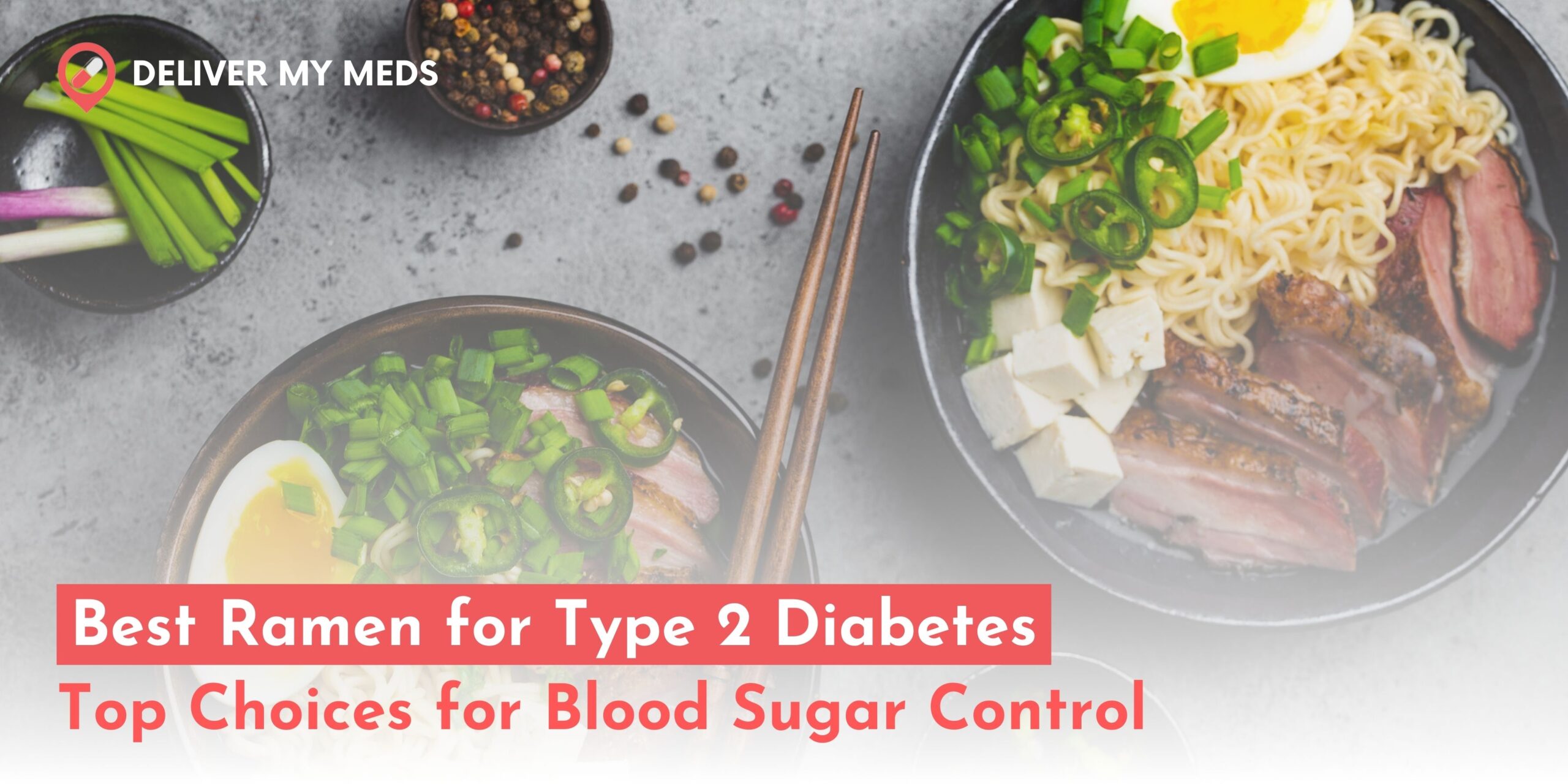
Ramen is a beloved comfort food for many, but for individuals with type 2 diabetes, it’s essential to be mindful of the nutritional content, especially carbohydrates and sodium. Traditional ramen is typically full of refined carbs, high sodium, and low nutritional value that can spike blood sugars and cause poor diabetes control. However, a couple of wise choices can keep the blood sugar healthy enough and control it.
We shall look at the best ramen for type 2 diabetes, what to watch out for when making a healthy choice, and how one can make their ramen dish diabetic-friendly.
Why traditional ramen is not a good choice for type 2 diabetes
Ramen from instant types is primarily made of refined wheat noodles. There is also a lot of sodium and unhealthy fats in them. Here are why these components become problematic for patients with type 2 diabetes.
- High Glycemic Index (GI): Refined wheat noodles are the most frequently used type of noodles in traditional ramen, and they have a high GI. Foods with a high GI tend to raise blood sugar levels sharply and make diabetes management difficult.
- High Sodium: Most ramen broths, especially instant ones, are high in sodium, and high sodium causes high blood pressure, which is a significant concern for people with diabetes.
- Low Nutritional Value: Instant ramen is low in fibre content, poor in protein, and lacking many other essential vitamins for regulating good blood sugar and good health.
Key Factors When Selecting the Best Ramen for Type 2 Diabetes
Note the following to make a proper choice for managing type 2 diabetes.
- Locate whole-grain ramen noodles: Choose ramen noodles made from whole grains like brown rice or whole wheat. Nuts such as brown rice or whole wheat have a lower glycemic index and are higher in fibre, which allows sugar to enter the bloodstream at a slower rate and thus can manage blood sugars.
- Choose low-sodium options: Buy low-sodium versions of ramen broths or make your own at home. High sodium raises the risk of hypertension, which is an essential concern in individuals with diabetes.
- Add fibre and protein: Spinach, bok choy, and mushrooms, along with a source of protein like tofu, chicken, or fish, complement the meal and ensure that blood sugar does not shoot up.
- Avoid instant noodles as they contain unhealthy fats, preservatives, and refined carbohydrates. Instead, choose fresh or frozen ramen.
Best Ramen Options for Type 2 Diabetes
Here are some of the best ramen choices for people with type 2 diabetes, focusing on those with lower glycemic indexes, whole grains, and healthier ingredients:
1. Shirataki Noodles (Konjac Noodles)
Shirataki noodles are made from konjac yam and are a great diet source for people with type 2 diabetes. They are, therefore, deficient in calories and carbs and contain water and fibre in most of their composition. The fibre, glucomannan, is resistant to digestion, slowing digestion and keeping blood sugar stable. Shirataki noodles have a very neutral flavour and absorb the taste, just like a good broth, providing an excellent base for a diabetes-friendly ramen dish.
2. Whole Wheat or Brown Rice Ramen
Whole wheat or brown rice noodles can be chosen for more traditional ramen. They have a much lower glycemic index than white refined noodles, giving you extra fibre, an essential element in regulating blood sugar levels. High in magnesium, brown rice ramen also regulates the amount of glucose and blood sugar within the bloodstream. Pair the noodle dish with a low-sodium broth and vegetables; you are ready for a fulfilling meal.
3. Low-sodium broth Ramen
Most pre-packaged ramen broths are high in sodium, but low-sodium versions are available. You can look for ramen marked with reduced sodium or make your own broth to regulate the amount of salt you use. A homemade broth made from fresh vegetables, herbs, and spices such as ginger and garlic reduces sodium and adds extra nutrients and flavour to your ramen.
4. Vegetable-Based Ramen
Mix greens like spinach, kale, cabbage, mushrooms, and bok choy with your noodles; these all have an increased number of fibres and nutrients one can get within the food. Antioxidants present in vegetables or vitamins and minerals can help keep the body and blood sugar properly managed. Fibre also makes an individual eat slower because the digestion of sugar in the body does not happen much faster, thereby not feeling hungry.
5. Protein-Rich Ramen
Add a protein source such as grilled chicken, tofu, eggs, or shrimp to balance your ramen meal. Protein controls blood sugar levels by slowing the digestion of carbohydrates. It is an excellent option because it is plant-based, low in carbs, and full of protein.
Preparing Diabetes-Friendly Ramen at Home
Making your ramen at home helps control all that goes in so that the result is more wholesome and aligns with one’s nutritional requirements. Here is a simple recipe for diabetes-friendly ramen:
Ingredients:
- 1 pack of whole wheat or brown rice ramen noodles
- 1-2 cups of low-sodium vegetable broth or homemade broth
- 1 cup of spinach or bok choy
- ½ cup of mushrooms, sliced
- 1 boiled egg or grilled chicken breast (optional)
- 1 tablespoon of low-sodium soy sauce
- 1 teaspoon of sesame oil
- 1 teaspoon of ginger, grated
- 1 garlic clove, minced
- 1 tablespoon of miso paste (optional)
Instructions:
- Bring the low-sodium broth to a boil in a pot and add the garlic, ginger, soy sauce, and miso paste (if using). Let it simmer for a few minutes to develop flavour.
- While the broth is simmering, cook the whole wheat or brown rice ramen noodles according to package instructions.
- Add the vegetables—spinach, bok choy, and mushrooms—to the simmering broth and let them cook for 2-3 minutes until tender.
- Once the noodles are cooked, drain them and put them in a bowl.
- Pour the hot vegetable broth over the noodles.
- Add boiled egg or grilled chicken, and top with sesame oil.
- Enjoy your nutritious, diabetes-friendly ramen!
Monitoring Blood Glucose While Enjoying Your Favorite Treat with CGM Devices
Monitoring the blood glucose level while indulging in your favourite is very crucial to people diagnosed with diabetes so that it does not exceed more than the healthy range. Continuous Glucose Monitoring devices make it easy by giving you real-time data, and thus, you can observe how a particular food product affects your glucose levels. These CGM devices, such as Freestyle Libre, Dexcom G6, and Medtronic Guardian Connect, have become very popular because ads and alerts show that your glucose levels are rising and getting too high or too low. You may indulge in some of your favourite foods with higher confidence, always making informed choices based on live glucose readings before and after meals so that you can never compromise your health.
Conclusion
You don’t have to stop cooking ramen altogether if you have Type 2 diabetes. By cooking smart, choosing whole grains and low-sodium broths, and adding fibre-rich vegetables and protein, this dish, which you love so much, can become your diabetes-friendly favourite. It is about moderation and adapting the original recipe to suit your blood sugar management and well-being goals.
With these tips, you can continue enjoying ramen while better controlling your diabetes. Always seek the advice of your healthcare provider or a nutritionist if you have any health requirements.



